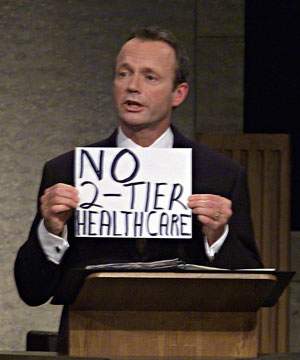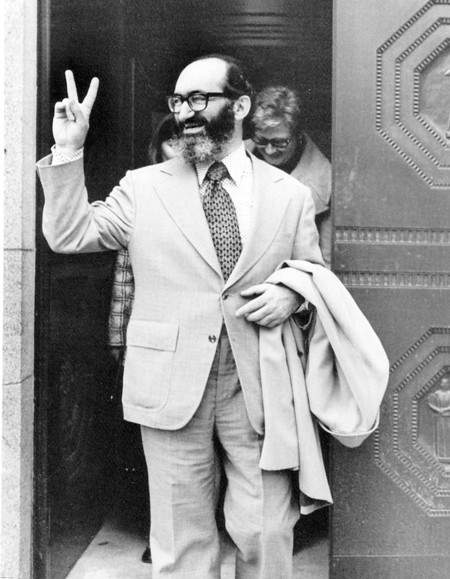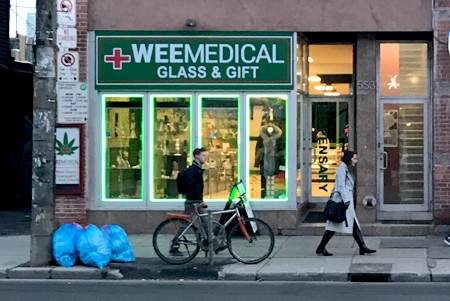
In recent years, one of the most defining elements of the Canadian identity has been the country’s social policies — the collection of laws and regulations that govern how Canadians live their lives, and what sorts of individual rights the government is willing to protect and defend.
Given that many Canadians like to focus on how their country is different from the United States, social policy is often seen as a window into the sort of values that make Canada a uniquely progressive country — though it would be a mistake to suggest all social policy is progressive or that progressive social policy has no Canadian critics.

In the 2001 Canadian federal election, Stockwell Day (b. 1950), the conservative candidate for prime minister, famously brandished this sign during a televised debate, lest anyone think he was soft on the issue of privatizing health care. Conservative politicians are often on the defensive about health care policy, since many conservative intellectuals and commentators would like to see more privatization in the system, yet these ideas are not considered popular with voters.
Whenever Canadians are polled about what makes them “proudest to be Canadian,” the Canadian health care system often tops the list. Beginning in the 1960s, Canada’s provincial governments began introducing government health insurance (sometimes known as medicare), to pay for hospital visits, operations, and other essential medical services. In 1984 the federal government passed the Canada Health Act which forced all provincial health plans to meet certain standards of coverage, and outlawed charging fees for medically-necessary services. Today, all Canadians are provided with comprehensive health insurance from birth through public health plans run by the various provincial governments (with funding help from Ottawa). The provincial governments now generally run most hospitals and clinics as well, with doctors and surgeons charging governments directly for their services. Very few privately-run hospitals or clinics exist in Canada these days.
Canada’s public health care system is one of the most generous in the world, but also quite expensive to maintain. In recent years, many provincial governments have started to scale back their scope of insurance coverage in order to make their medicare programs more financially sustainable, and Canadians often purchase supplementary private health insurance to pay for things like dentist trips, eye exams and any operation or treatment the government considers “non-essential.” Such plans, sometimes called extended medical coverage are often provided to working Canadians by their employers as a perk of the job. Private health insurance cannot — by law — pay for services covered by a provincial, public health plan, however.
How to guarantee the long-term “survival” of the Canadian health care regime is one of the most heated debates in contemporary Canadian politics. On the right, it’s common to advocate greater privatization of medical services, including more privately-run, fee-based clinics and surgeons to give more choice to patients. Folks on the left, in turn, are generally extremely critical of anything that smacks of edging towards a so-called “two-tiered” system, where Canadians with money can buy their way into better medical care than those who use the public system. To the broader public, however, the status quo is considered nearly sacred, which leads most politicians to shy away from proposing dramatic reforms.

Born in Poland to a Jewish family, Dr. Morgentaler survived death in a concentration camp and was a frustratingly complex foe for pro-life groups. Brash and outspoken, he is easily one of the most controversial Canadians of all time.
Owing in part to the pressures of the country’s large Catholic population, abortions in Canada were banned entirely until 1969, and then only permitted under narrow conditions when the mother’s health could be proven to be in danger. Illegal abortions continued in the background, however, and in 1988, a particularly unapologetic abortion surgeon named Dr. Henry Morgentaler (1923-2013) went before the Supreme Court of Canada to face charges. Siding with Morgentaler, the court ruled the country’s existing abortion regulations represented an unconstitutional burden on the rights of women, and the legal restrictions on the procedure were struck down.
Though the Supreme Court’s ruling said it would be permissible for the government to place some limitations on abortion, no Canadian government ever has. Canadian women thus have a universal right to abort at any stage of pregnancy — even the final weeks — which is a degree of permissiveness largely unseen elsewhere in the western world. At the same time, however, there do exist some de facto limitations on abortion determined by the ethics of individual doctors. In many parts of the country it can be difficult to find doctors willing to perform so-called late term abortions.
Abortion is a very controversial topic in contemporary Canada, and tops the list of things to avoid discussing in polite company. There are a number of passionate pro-life and pro-choice activist groups all over the country, prone to staging aggressive demonstrations and protests in order to ensure their opinions are heard. All of Canada’s political parties are officially pro-choice, however, and proposals to change Canadian abortion policy are almost never heard in mainstream political discussion. Since the 1990s, there has been a strong consensus among Canada’s party leaders that the “abortion debate” is a topic too politically explosive to reopen, so the status quo stays. This political consensus masks the degree Canadians themselves disagree about the issue however — a 2018 poll found Canadians quite evenly split when it was asked whether “there should be laws on abortion in Canada.”

A medical marijuana store in downtown Toronto. Though many such stores are not actually licensed medical retailers, police in big cities rarely enforce such laws, allowing them to operate in a state of immunity.
Liquor was associated with all sorts of social ills in early Canada, and at various times during the early 20th century most provinces experimented with banning the sale and production of alcohol in various ways. This era of so-called prohibition was not the magical solution many had hoped for, however, and by the 1920s, most provinces had changed their laws to re-allow the sale of alcohol, but only within certain tight regulations. To this day, Canadian provinces will often have complicated rules governing just how or where booze can be sold; in some provinces it may only be sold by special government-run liquor stores, in others the law may require hard alcohol and beer to be sold at different locations. Almost all forbid the sale of liquor at 24-hour shops like supermarkets and corner stores. Provinces generally allow citizens to brew (but not sell) their own beer and wine, but it is against federal law to make distilled liquor without a permit.
Canada’s legal drinking age is set by the provinces. In Alberta, Manitoba and Quebec the age is 18, everywhere else it is 19. Most provinces also have strict laws against consuming alcohol in public places and low standards for what constitutes “driving while under the influence.”
Marijuana was legalized for personal consumption across Canada in the fall of 2018. In theory, there are a lot of strict laws dictating exactly when, where and how marijuana can be bought, sold, and used, but it’s unclear to what degree these rules will be enforced. Prior to 2018, Canada’s anti-pot laws were rarely enforced and offenders rarely faced serious punishment, particularly in big cities. Since 2001, it has been legal for Canadian doctors to prescribe marijuana for medical reasons, and in 2014 the federal government authorized the licensing of private retail distribution of medicinal marijuana — a decision which triggered a dramatic increase of pot shops in urban centres, most of which promote rather hazy definitions of “medically necessary” pot.
Hard drugs like heroin, cocaine, LSD, and meth are all banned in Canada.
Canadians generally take their constitutionally-protected right to free expression (the freedom to say or write whatever you want) very seriously, but the privilege is not an absolute one. As discussed in the Canadian Constitution chapter, Canada’s Charter of Rights and Freedoms allows “reasonable limits” to be placed on most civil rights, and over the years the government has used this authority to pass some legal limits on freedom of speech. Canada has relatively uncontroversial laws that forbid spreading deliberate, malicious lies about other people (known as slander or libel) as well as copying or attempting to profit from other people’s ideas (copyright infringement). It is also generally against the law to use speech to encourage, advise, or provoke the committing of crimes.
It is still technically illegal to sell or produce obscene material in Canada and the Canadian government often bans the import of specific magazines, books, comics, containing very extreme depictions of sexual violence or perverted sex acts like incest or pedophilia. More “mainstream” pornography is only available in specially licensed stores or theaters, though this has obviously become far less relevant in the internet age. Provincial governments have similar laws banning children from buying pornography, excessively violent video games, or tickets for movies with “mature” content
Canada has hate speech laws that make it a crime to publicly incite “hatred against any identifiable group” such as racial, religious, or sexual minorities, through written statements or other forms of media. There are exemptions for matters of sincere opinion or religious belief, and the attorney general of Canada must generally choose to initiate prosecution. More sweeping laws that made it a crime to “expose a person or persons to hatred or contempt” on the basis of identity were abolished in 2014. Sentences for the most extreme forms of hate speech, particularly hate speech that “promotes genocide,” can reach a maximum of two to five years in prison. New national security legislation makes it a crime to distribute media that “advocates or promotes” terrorism, as well.

It's against the law to own a "replica firearm" in Canada, which the law defines as "any device that is designed or intended to exactly resemble, or to resemble with near precision, a firearm." In order to avoid breaking the law, toy guns, paintball guns, and other play weapons are often cartoonishly proportioned and have bright orange muzzles.
As a country with long traditions of hunting and trapping, Canada’s rate of gun ownership has historically been high, and Canada has some of the most liberal gun laws on earth. According to the Canadian National Firearms Association, there are presently about 21 million guns in Canada owned by about seven million Canadians — or about 20 per cent of the population — the majority of whom are recreational hunters. The most commonly owned guns in Canada are rifles and shotguns.
The Canadian government requires citizens to pass a safety course and undergo a background check before they can get a firearms Possession and Acquisition Licence (PAL) to legally own or buy arms, and laws governing gun storage and transportation are detailed and strict. Unlike most countries, Canada does not have national gun registry, though handgun owners must obtain a registration certificate to prove they are a legal owner. The government maintains a long list of banned guns, mostly semi-automatic rifles, though they can be rented for use in shooting ranges.
Gun control in Canada has proven to be an issue which sharply divides the country in terms of rural-versus-urban. For those who live in big cities, guns tend to be associated with inner-city crime, particularly gangland murders, and support to severely control or outright ban gun possession is usually high. Canadians who live in more rural parts of the country, in contrast, usually associate guns with hobbies like hunting, sport shooting and collecting, and see gun control as an undue burden that punishes the otherwise law-abiding.
Canada has a fairly robust set of legal protections designed to prevent Canadians from being discriminated against on the basis of things they can’t control, such as race, gender, religion, or sexual orientation.
The Canadian Charter of Rights and Freedoms is a section of the Canadian Constitution that makes it illegal for the government of Canada, or any provincial government to pass laws that either explicitly discriminate against certain Canadians on the basis of their identity, or simply place an unfair burden on one group over another. The Supreme Court of Canada routinely overturns laws they perceive to be discriminatory on the grounds of Charter protections.
Canada also has a sweeping piece of legislation called the Canadian Human Rights Act that forbids private entities, such as employers, landlords, schools, and stores from discriminating against clients or customers on the basis of identity. Discrimination cases of these sorts are investigated by the Canadian Human Rights Commission and adjudicated by a court-like body known as the Canadian Human Rights Tribunal that has the power to issue fines and or other corrective actions. The various provincial governments have their own human rights laws, commissions, and tribunals as well.